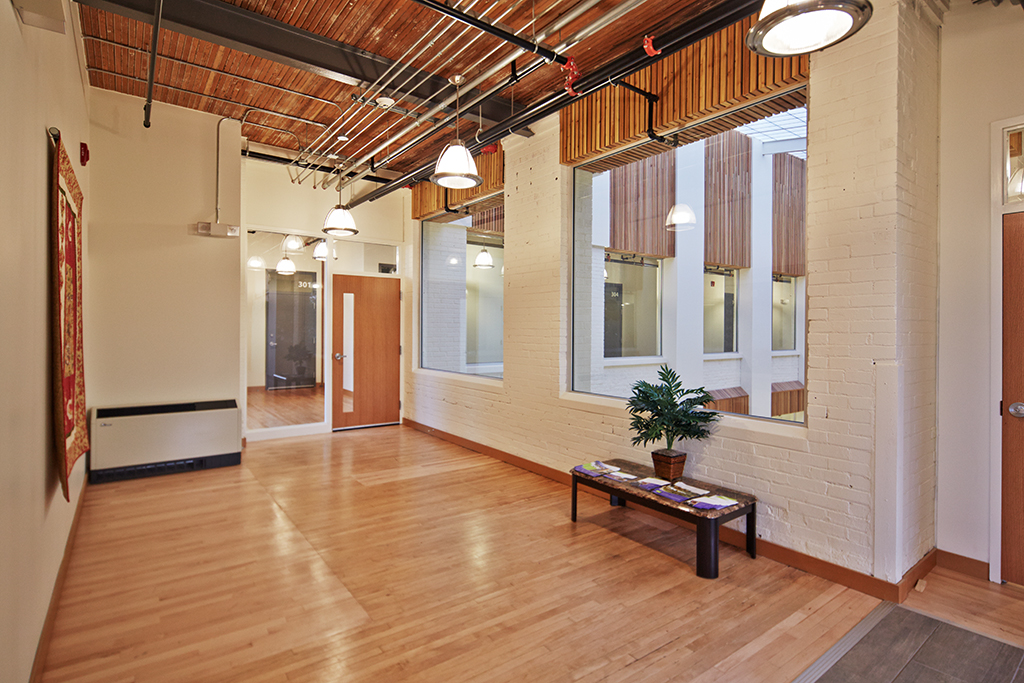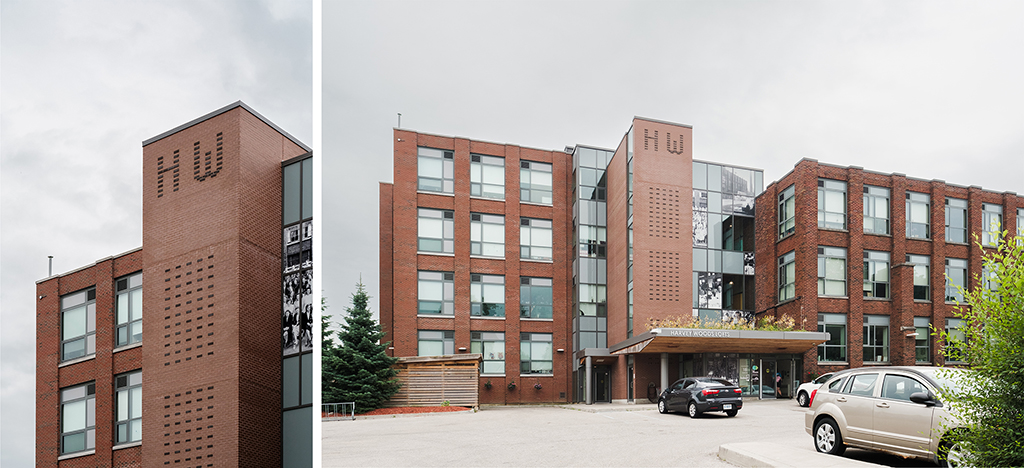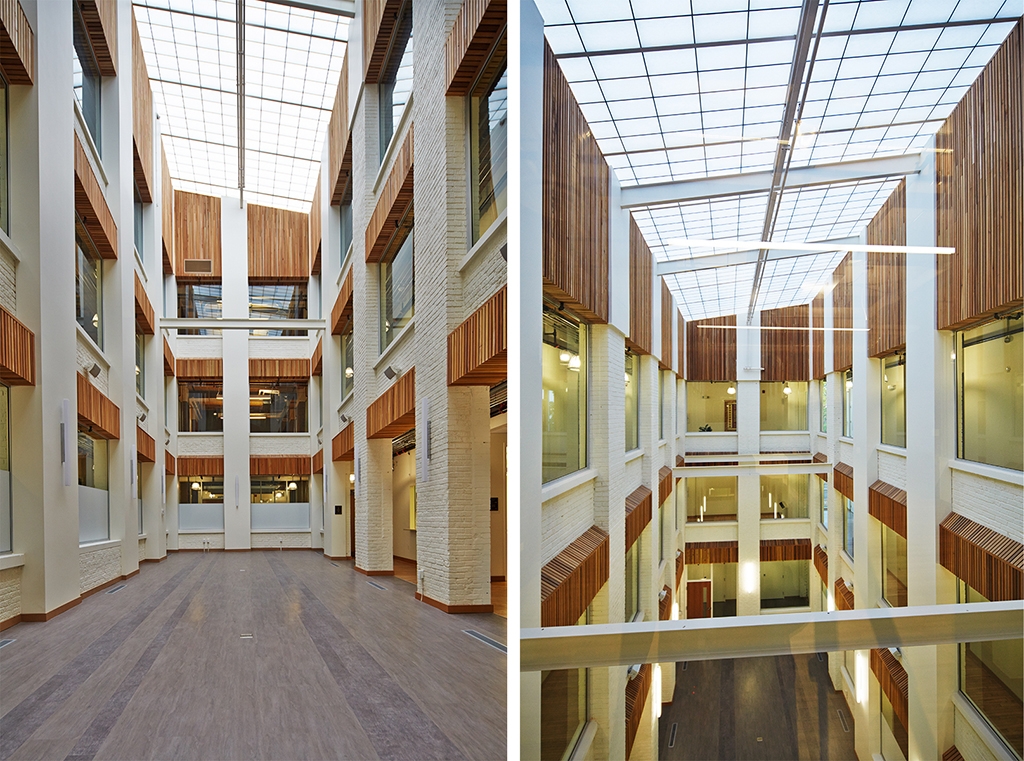Location: Woodstock, Ontario
Completed: 1918, 2015 (phase 1), 2017 (phase 2)
Architect: Invizij Architects Inc.
Nominated by: Ernie Hardeman, MPP (Oxford)
Harvey Woods Lofts stands as a testament to the transformative power of adaptive reuse, reanimating a historic knitting factory into 80 new affordable housing units and showing us along the way the advantages of reusing our existing buildings to address the housing crisis.
A Building of Local Significance
Originally built in 1918, the three-storey Harvey Woods factory has been a significant part of Woodstock’s history and community for more than 100 years. Commissioned by the Harvey Woods Company, the red brick-and-beam building housed nearly 1,000 local workers who manufactured socks, hosiery, and undergarments from 1918 until its closure in 1990. It was one of the largest single employers in the city, and many of the residents still have ties to those who worked in the building.
 1956 group portrait of workers at the former Harvey Woods Mills. Image courtesy of Invizij Architects Inc.
1956 group portrait of workers at the former Harvey Woods Mills. Image courtesy of Invizij Architects Inc.
After its closure, the factory remained vacant for over two decades—remediation challenges caused by a neighbouring gas station proved too onerous to make conversions feasible for most developers. It wasn’t until 2012 when
Indwell, a Christian charity providing housing and support services to vulnerable Ontarians, saw the potential of the historic mill and took on the challenge of transforming the site into a new use. Indwell’s portfolio already included the conversion and renovation of existing structures, and where others saw challenges, they saw an opportunity to ground the new development with a strong sense of place.
The sense of community was in full display during an open house held shortly before starting renovations, with some 500 community members showing up to say goodbye to the factory and welcome its new use as supportive affordable housing.
Throughout design and construction, special attention was paid to retaining as much of the building’s original features as possible, including the maple flooring, wood columns, brick walls, and steel beams. An old vault was converted into a bathroom in the sole studio apartment in the building, and factory doors have been given new life as wayfinding at each level.
 Interior hallway with atrium beyond. Image courtesy of Invizij Architects Inc.
Interior hallway with atrium beyond. Image courtesy of Invizij Architects Inc.
Where new elements were added, they were treated as opportunities to further emphasize the site’s history. The new wing repeats the rhythm, materials, and window pattern of the old factory, while a new glass curtain wall is animated with historic black-and-white images of the workers who once occupied the site. Standing proudly above the new entrance, the initials “HW” are inlayed into the new brick facade as a contemporary nod to traditional brick-laying technique.
 Left: Close-up of brick detail. Right: Completed Phase 2 with new addition on the left. Images by Kurtis Chen.
Left: Close-up of brick detail. Right: Completed Phase 2 with new addition on the left. Images by Kurtis Chen.
Adapting A Factory Into Housing
At first glance, a factory building might seem like an unusual choice for residential conversion, but these century-old factories have a lot of features that make them great candidates for adaptive reuse.
They are sturdy buildings, built to hold heavy equipment, supplies, and workers, and their regular bays make them easy to internally reconfigure. Unlike their modern counterparts that use electrical lighting, these older factories were highly dependent on natural light to illuminate workstations, which means they feature large windows all around their perimeter.
Still, there is one central challenge that these buildings face for conversion from industrial to residential: their deep floor plates. In residential buildings, shallow floor plates purposely allow daylight to penetrate as much of the livable spaces as possible—this is why multi-family buildings usually put hallways, elevators, and stairs at the centre, giving units priority access to windows. On the other hand, factories, offices, and warehouses—particularly after the popularization of electric lighting—do not have the same daylighting concerns, and thus maximize space efficiency by creating much deeper floor plates with many areas far from windows.
These deep floor plates present a challenge for conversions, since much of the area is not ideal for residential units but are too large to fill with just elevators and stairs.
For Harvey Woods Lofts, Invisij Architects saw an ingenious solution early-on: cutting out a new atrium in the middle of the factory. This architectural move solved a number of different challenges, providing additional daylight into the building through a new central skylight and creating a new space for community activities—an important programming element for supportive housing. Last but not least, by organizing the apartments and hallways around this new atrium, it also provides opportunities for neighbours to visually connect to one another and see group activities going on, further fostering a sense of community.
 Images showing interior atrium. Images courtesy of Invizij Architects Inc.
Images showing interior atrium. Images courtesy of Invizij Architects Inc.
Another challenge facing the conversion was the long-term costs of operating the building. While old buildings have a lot of positive features, their energy performance is often below modern standards. The renovation provided an opportunity to make the building much more energy efficient with new insulation and windows, as well as the installation of a geothermal heat pump system enabled by the presence of a local aquifer situated at just the right depth. Hot air that rises up through the new atrium is recirculated during cold seasons or vented out during warm seasons.
The resulting building is an asset that significantly reduces operational burdens for the lifetime of the building—a big plus for a non-profit!
These investments were only made possible with significant contributions from federal and provincial governments. The municipality of Woodstock also played a role, helping the project early-on with remediation work for the site.
By making the most of the existing building while also integrating modern features and systems, Harvey Wood Lofts demonstrates that heritage retention and housing affordability can go hand in hand and result in new housing developments deeply rooted within the community.
This post is part of the OAA’s Queen’s Park Picks 2024 series, where Ontario’s Members of Provincial Parliament (MPPs) were encouraged to nominate a building in their riding for a chance to learn more about it. This year, MPPs were asked to consider various typologies related to housing when making their suggestion, tying into the 2024 OAA Conference theme, Housing: Pushing the Envelope. Check out the rest of the series to learn more about great buildings across the province.